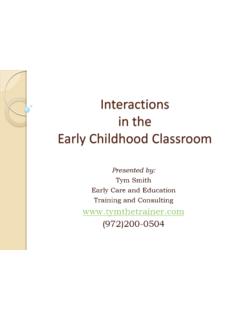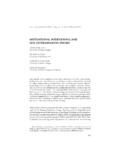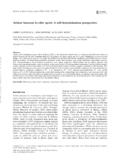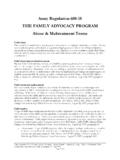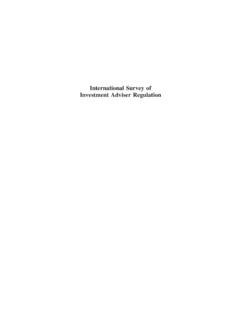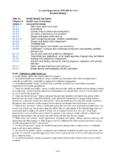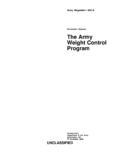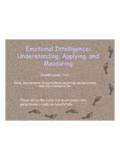Transcription of Serious Occurrence Reporting Procedures for Service ...
1 Revised August 2009 Serious Occurrence Reporting Procedures for Service Providers in the Northern Region Ministry of Community Minist re des services and Social services sociaux et communautaires Ministry of Children Minist re des services and Youth services l enfance et la jeunesse 2 TABLE OF CONTENTS Serious Occurrence Glossary of Serious Occurrence Categories and Reporting Serious Occurrence Reporting Summary of ENHANCED Serious INTRODUCTION All providers of services that are funded, licensed or operated by the Ministry of Community and Social services (MCSS) and the Ministry of Children and Youth services (MCYS), are responsible for delivering services that promote the health, safety and welfare of clients.
2 Service providers are accountable to the ministries to demonstrate that their services are consistent with relevant legislation, regulations and/or ministry policy. Serious Occurrence (SO) Reporting is one of many tools providing the ministries and the Service provider with an effective means of monitoring the appropriateness and quality of Service delivery. Monitoring includes an ongoing review of Service provider practices, Procedures , and training needs. Information about Serious occurrences is available to regional program supervisors, program advisers, licensing and compliance staff and corporate offices of MCSS and MCYS.
3 This document describes the process and Procedures for Reporting Serious occurrences. It is intended for use by Service providers as an orientation for new staff, a refresher for experienced staff and a quick reference for everyone involved in Serious Occurrence Reporting . These guidelines replace the Serious Occurrence Reporting Procedures for Service Providers issued by the then Ministry of Community, Family and Children s services in September 2002 and complement the Enhanced Serious Occurrence Reporting and Monitoring documents distributed by MCSS and MCYS in January 2006. Serious Occurrence Reporting Glossary of Terms The following terms and definitions are provided to facilitate Serious Occurrence Reporting .
4 24 Hours - clock starts when any of the Service provider s staff becomes aware of an incident or when the Service provider deems the incident to be Serious . Children (non-child welfare) - ages 0-18 years. - residential refers to a child receiving Service 24/7 from the Service provider, including out-of-home respite care, residential services for children with developmental disabilities, or a child residing with his mother in a Violence Against Women shelter, etc. - non-residential refers to a child receiving community Service at the time of the incident, including children attending day cares, Ontario Early Years Centres/Parent Resource Centres, and counselling services , etc.
5 Children (child-welfare) - ages 0-21 years. - child must be in CAS care (with the exception of category #1 death) or receiving services pursuant to an ECM agreement. - does not include children on home access visits with parents or guardians. - includes client on Extended Care and Maintenance (ECM) or Independent Living (IL). Adults - ages 18 + years (with the exception of child welfare client on ECM/IL). - residential includes client receiving Service through Interpretor/Intervenor services , Group Living Supports (a group home), Innovative Residential, Supportive Individual Living (SIL) supports, Associative Living Supports, or women living in VAW shelters, etc.
6 - non-residential includes client receiving community participation supports and/or vocational alternative supports such as a day program, respite, support from an Adult Protective Service Worker (APSW), and parents attending Ontario Early Years Centres/Parent Resource Centres, etc. 4 Serious - an Occurrence is Serious if it falls within the definitions in these guidelines and has important or possibly dangerous consequences. Participating in a Service - client is in direct receipt of Service from a funded Service provider and/or under the direct care of staff, volunteers, caregivers, etc. (Note: Clients receiving residential care are considered to be always participating in a Service .)
7 Physical Restraint - using a holding technique learned from a Ministry-approved training program to restrict the resident s ability to move freely. - does not include the restriction of movement, physical redirection or physical prompting, if the restriction of movement is brief, gentle and a part of a behaviour teaching program, or the use of helmets, protective mitts or other equipment to prevent a resident from physically injuring or further physically injuring himself or herself. - Child care programs are not permitted to use physical restraints under this definition. - See CFSA 1990, Regulation 70, Sections and DSA 1990, Regulation 272, Sections 17-21 for further information on the use of physical restraints.
8 Serious Occurrence Categories and Definitions MCSS and MCYS have provided eight categories of Serious occurrences to be reported by the Service provider to the ministry. Please note that the examples supplied in each category are meant for illustrative purposes only and do not constitute an exhaustive list of incidents considered a Serious Occurrence . 1. Any death of a client which occurs while participating in a Service , including all clients receiving community-based support services that are funded or licensed by the MCSS and/or MCYS. As well, include: any child receiving Service from a Children s Aid Society at the time of their death or in the 12 months immediately prior to their death1.
9 Any VAW client death at a shelter, at an agency during VAW counselling, as a result of intimate femicide (at the hands of her abuser) while in receipt of Service . 1 Ontario. Office of the Chief Coroner for the Province of Ontario. Child Death Reporting and Review Joint Directive. March 2006 52. Any Serious injury to a client which occurs while participating in a Service . A factor to consider in deciding if an injury should be reported as a Serious Occurrence is whether professional medical treatment ( doctor or dentist) is required, not in-house first aid.
10 Serious injuries include: a) An injury caused by the Service provider, , lack of or inadequate staff supervision, neglect/unsafe equipment, improper/lack of staff training, medication error resulting in injury. b) A Serious accidental injury, , sports injury, fall, burn, etc. c) A Serious non-accidental injury, , suicide attempt, self-inflicted or unexplained injury. 3. Any alleged abuse or mistreatment of a client2 3 which occurs while participating in a Service , , allegations of abuse against staff, foster parents or other foster family members , volunteers, temporary caregivers, police/court staff while young persons are in custody, drivers providing client transportation.
